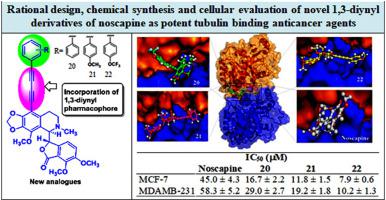Journal of Molecular Graphics and Modelling ( IF 2.7 ) Pub Date : 2021-05-05 , DOI: 10.1016/j.jmgm.2021.107933 Amiya Kumar Patel 1 , Rajesh Kumar Meher 1 , Praveen Kumar Reddy 2 , Ravi Kumar Pedapati 2 , Pratyush Pragyandipta 1 , Srinivas Kantevari 2 , Manas Ranjan Naik 3 , Pradeep Kumar Naik 1

|
We present a new class of derivatives of noscapine, 1,3-diynyl-noscapinoids of an antitussive plant alkaloid, noscapine based on our in silico efforts that binds tubulin and displays anticancer activity against a panel of breast cancer cells. Structure-activity analyses pointed the C-9 position of the isoquinoline ring which was modified by coupling of 1,3-diynyl structural motifs to rationally design and screened a series of novel 1,3-diynyl-noscapinoids (20–22) with robust binding affinity with tubulin. The selected 1,3-diynyl-noscapinoids, 20–22 revealed improved predicted binding energy of −6.568 kcal/mol for 20, -7.367 kcal/mol for 21 and -7.922 kcal/mol for 22, respectively in comparison to the lead molecule (−5.246 kcal/mol). These novel derivatives were chemically synthesized and validated their anticancer activity based on cellular studies using two human breast adenocarcinoma, MCF-7 and MDAMB-231, as well as with a panel of primary breast cancer cells isolated from patients. Interestingly, all these derivatives inhibited cellular proliferation in all the cancer cells that ranged between 6.2 to 38.9 μM, which is 6.7 to 1.5 fold lower than that of noscapine. Unlike previously reported derivatives of noscapine that arrests cells in the S-phase, these novel derivatives effectively inhibit proliferation of cancer cells, arrests cell cycle in the G2/M-phase followed by apoptosis and appearance of apoptotic cells. Thus, we conclude that 1,3-diynyl-noscapinoids have great potential to be a novel therapeutic agent for breast cancers.
中文翻译:

新型Noscapine 1,3-二炔基衍生物作为有效的微管蛋白结合抗癌剂的合理设计,化学合成和细胞评价
基于我们在计算机上的努力,结合微管蛋白并显示出对一组乳腺癌细胞的抗癌活性,我们提出了一类新型的Noscapine衍生物,一种镇咳植物生物碱的1,3-二炔基-Noscapinoids,Noscapine 。结构活性分析指出,异喹啉环的C-9位置可以通过偶联1,3-二炔基结构基序进行修饰,以进行合理设计,并筛选出一系列具有较强耐受性的新型1,3-二炔基-类芥子油苷(20–22)与微管蛋白的结合亲和力。选定的1,3-二炔基-类胡萝卜素类化合物20-22预测的结合能提高了-6.568 kcal / mol,对于20为-7.367 kcal / mol,对于21为-7.922 kcal / mol,对于22为-7.922 kcal / mol。与铅分子(-5.246 kcal / mol)相比。这些新颖的衍生物是化学合成的,并基于使用两种人乳腺腺癌MCF-7和MDAMB-231以及从患者中分离出的一组原代乳腺癌细胞的细胞研究,验证了它们的抗癌活性。有趣的是,所有这些衍生物均抑制所有癌细胞的细胞增殖,其范围为6.2至38.9μM,比Noscapine低6.7至1.5倍。不同于先前报道的将Noscapine停滞在S期的细胞的Noscapine衍生物,这些新型衍生物有效抑制癌细胞的增殖,将细胞周期停滞在G2 / M期,随后发生凋亡和凋亡细胞的出现。因此,我们得出结论,











































 京公网安备 11010802027423号
京公网安备 11010802027423号